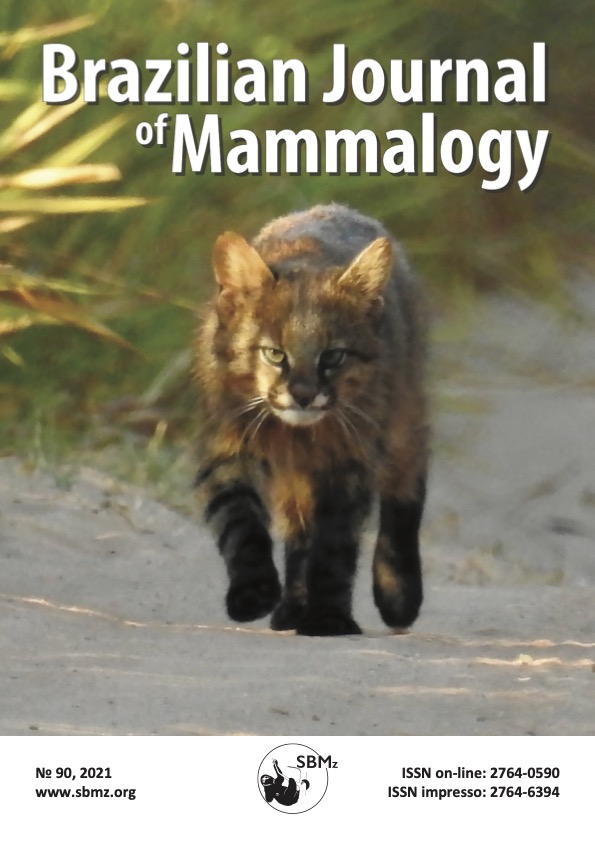Albinism in lowland tapir (Tapirus terrestris)
A case of an orphaned calf tapir from Atlantic Forest
DOI:
https://doi.org/10.32673/bjm.vi90.36Keywords:
Albino, Jurupará State Park, Legado das Águas Reserve, Ungulate;, Wild AnimalsAbstract
Here we report the encounter of an albino lowland tapir in the Brazilian Atlantic Forest. On November 23rd 2020, a female albino calf was found within the buffer zone of Jurupará State Park, in the city of Piedade, São Paulo State, Brazil. The orphaned female tapir was rescued and brought to Parque Zoológico Municipal Quinzinho de Barros. Albino tapirs have been reported in another forest, Legado das Águas Reserve, about 20 km from this calf was rescued. Thus, this new record of albino tapir highlights the importance of preserving and maintaining connectivity among the conservation units in that region.
References
Aximoff IA, Rosa CA. 2016. First records of albinism in grey headed tayra (Carnivora, Mustelidae) and occurrence in high altitude grassland in Brazil. Oecologia Australis 20: 526‑531.
Bornschein MR, Corrêa L, Belmonte-Lopes R, Klemann Júnior L, Caceres NC, Pie MR. 2012. The use of highlands by the Lowland Tapir (Tapirus terrestris) in the southern Brazilian Atlantic Forest. Neotropical Biology and Conservation 7: 210‑213.
Cuxim-Koyoc A, Escalante-Avilés I, Aragón-Pech R, Pinto-Escalante D, Reyes-Novelo E, Ruiz-Piña HÁ. 2020. Albinism in Didelphis virginiana (Kerr, 1792): the first reported case in Mexico. Mammalia 84: 144‑149.
Donny Y, Zainal ZZ, Jeffrine Japning RR, Che Ku MZ, Cwar Mohd ZZ, Enos J, Rahmat T, Kadir AAH. 2019. Growth rate and pelage colour changes of a captive bred Malayan tapir (Tapirus indicus). Malaysian Journal of Veterinary Research 10: 25‑31.
Espinal M, Mora JM, Ruedas LA, López LI, Marineros L. 2016. A case of albinism in the Central American spider monkey, Ateles geoffroyi, in Honduras. Mastozoología Neotropical 23: 63‑69.
Fertl D, Pusser LT, Long JJ. 1999. First record of an albino bottlenose dolphin (Tursiops truncatus) in the Gulf of Mexico, with a review of anomalously white cetaceans. Marine Mammal Science 15: 227‑234.
Fundação Florestal do Estado de São Paulo. 2010. Resumo executivo do Plano de manejo do Parque Estadual do Jurupará. Disponível em: https:// www.infraestruturameioambiente.sp.gov.br/fundacaoflorestal/ planos-de-manejo/planos-de-manejo-planos-concluidos/plano-demanejo-pe-do-jurupara. Acessado em: 19 de dezembro de 2020.
Garcia MJ, Medici EP, Naranjo EJ, Novarino W, Leonardo RS. 2012. Distribution, habitat and adaptability of the genus Tapirus. Integrative Zoology 8: 121‑122.
García-Casimiro E, Santos-Moreno A. 2020. First record of albinism in the paca Cuniculus paca (Rodentia, Cuniculidae) in southeast Mexico. Neotropical Biology and Conservation 15: 195‑200.
Kiprono SK, Chaula BM, Beltraminelli H. 2014. Histological review of skin cancers in African Albinos: a 10-year retrospective review. BMC Cancer 14: 157. Laikre L, Andrén R, Larsson HO, Ryman N. 1996. Inbreeding depression in brown bear Ursus arctos. Biological Conservation 76: 69‑72.
Landis MB, Candisani L, Munhoes LP, Gebin, JCZ, Rezende F, de Jesus MMF, Medici EP, Ferraz KMPMB. 2020. First record of albino lowland tapirs (Tapirus terrestris Linnaeus 1758) in an important Brazilian Atlantic Forest hotspot. Mammalia 84: 601‑604.
Montoliu L, Grønskov K, Wei AH, Martínez‐García M, Fernández A, Arveiler B, Morice‐Picard F, Riazuddin S, Suzuki T, Ahmed ZM, Rosenberg T, Li W. 2014. Increasing the complexity: new genes and new types of albinism. Pigment Cell & Melanoma Research 27: 1‑18.
Oliveira HF, Aguiar LM. 2008. A new case of complete albinism in a bat from Brazil. Chiroptera Neotropical 14: 421‑423. Padilla M, Dowler R. 1994. Tapirus terrestres. Mammalian Species 481: 1‑8.
Prado-Martinez J, Hernando-Herraez I, Lorente-Galdos B, Dabad M, Ramirez O, Baeza-Delgado C, Morcillo-Suarez C, Alkan C, Hormozdiari F, Raineri E, Estellé J, Fernandez-Callejo M, Valles M, Ritscher L, Schöneberg T, de la Calle-Mustienes E, Casillas S, Rubio-Acero R, Melé M, Engelken J, Caceres M, Gomez-Skarmeta JL, Gut M, Bertranpetit J, Gut IG, Abello T, Eichler EE, Mingarro I, Lalueza-Fox C, Navarro A, Marques-Bonet T. 2013: The genome sequencing of an albino Western lowland gorilla reveals inbreeding in the wild. BMC Genomics 14: 363.
Ribeiro MC, Metzger JP, Martensen A, Ponzoni F, Hirota MM. 2009. Brazilian Atlantic forest: how much is left and how is the remaining forest distributed? Implications for conservation. Biological Conservation 142: 1141‑1153.
Ribeiro R, Siqueira-Silva DH. 2020. First report of complete albinism in Mazama americana (Erxleben, 1777) in the Biological Reserve of Tapirapé, Oriental Amazon, Brazil. Acta Scientiarum. Biological Sciences 42: e46734.
Robinson R. 1973. Acromelanic albinism in mammals. Genetica 44: 454‑458.
Roca LL, Tokuda M, Pessutti C, Pereira P, Costa ALM, Teixeira RHF. 2020. Relações entre o Parque Zoológico Municipal Quinzinho de Barros e a Biodiversidade Faunística de Sorocaba. Pp. 319‑336, In: Smith WS (Ed), Biodiversidade do Município de Sorocaba: Atualização e subsídios para a sua conservação. Universidade Paulista, Grupo de Pesquisa Ecologia Estrutural e Funcional de Ecossistemas, Sorocaba.
Romero V, Tirira DG. 2017. Leucistic Antarctic fur seal (Arctocephalus gazella) at Robert Island, South Shetland Islands, Antarctica, with a note on colour morph nomenclature. Polar Biology 40: 1893‑1897.
Romero V, Racines-Márquez CE, Brito J. 2018. A short review and worldwide list of wild albino rodents with the first report of albinism in Coendou rufescens (Rodentia: Erethizontidae). Mammalia 82: 509‑515.
Sabater Pi J. 1967. An albino lowland gorilla from rio Muni, West Africa, and notes on its adaptation to captivity. Folia Primatologica 7: 155‑160.
Stumpp R, Casali D, Cunha H, Paglia A. 2019. Complete albinism in Oxymycterus dasytrichus (Schinz 1821) (Rodentia: Cricetidae). Mammalia 83: 281‑286.
Downloads
Published
How to Cite
Issue
Section
License
Copyright (c) 2021 Brazilian Journal of Mammalogy

This work is licensed under a Creative Commons Attribution 4.0 International License.


